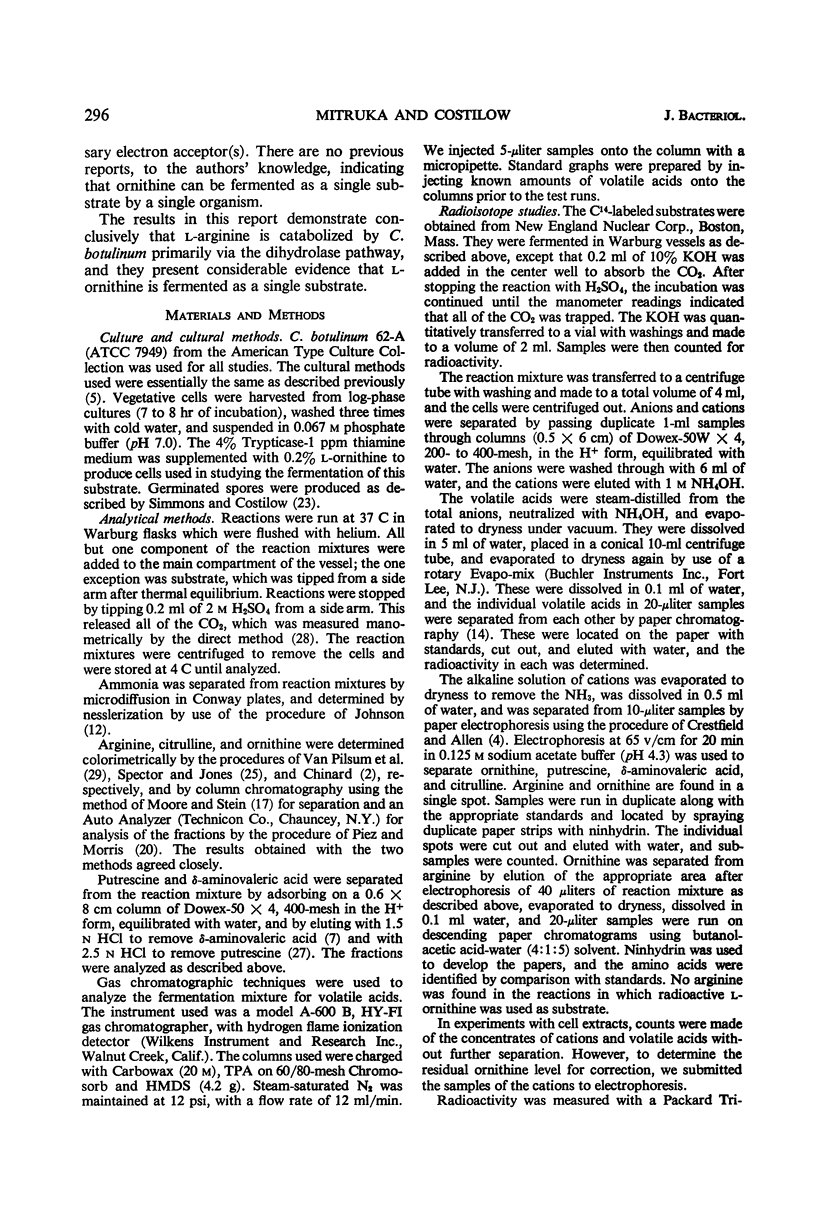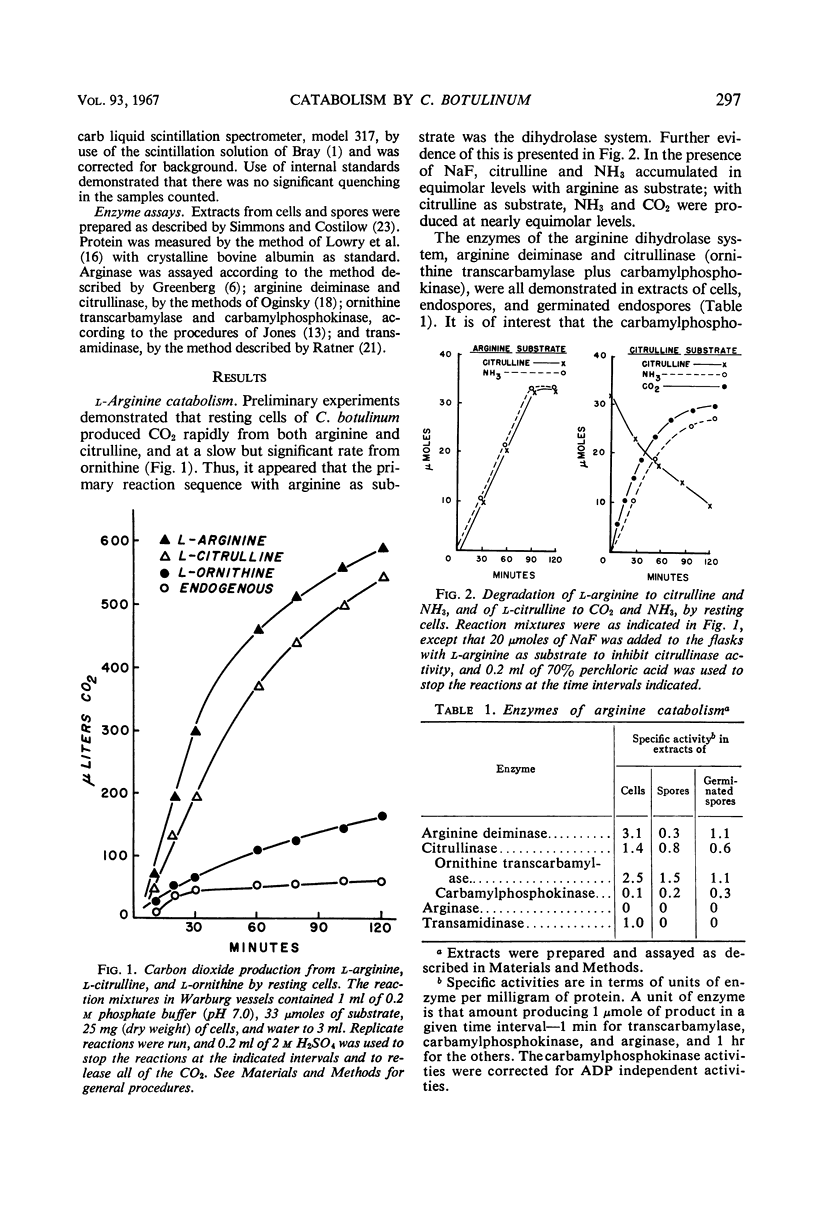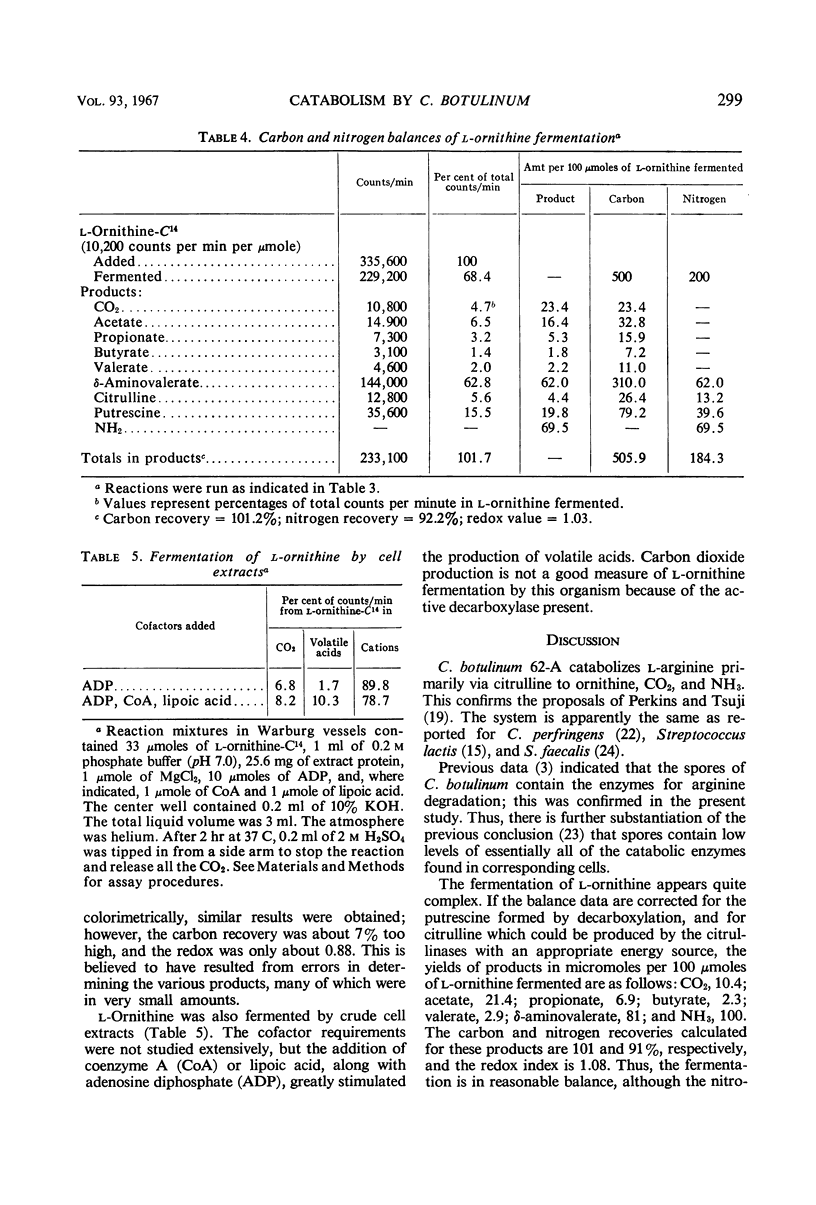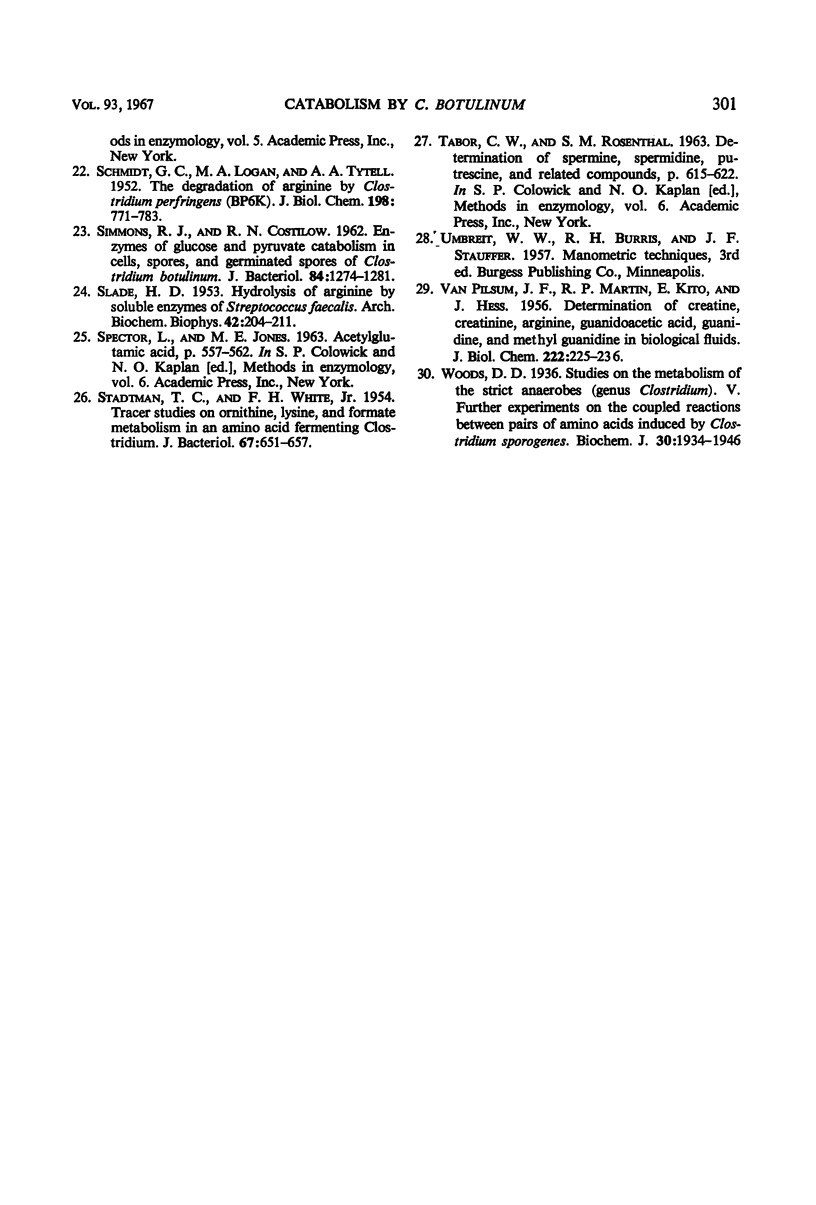Abstract
Clostridium botulinum 62-A was shown to catabolize l-arginine via citrulline to ornithine, NH3, and CO2. The individual enzymes of the dihydrolase system were all demonstrated in extracts of cells, spores, and germinated spores. There was no liberation of urea from l-arginine, so no functional arginase enzyme is present, but there was some transamidinase activity in cell extracts. l-Ornithine was degraded at a significant rate by cells grown in an l-ornithine-supplemented medium; it was partially decarboxylated to putrescine and partially fermented to NH3, CO2, volatile acids, and δ-aminovaleric acid. Results from the fermentation of l-ornithine-C14, -1-C14, and -2-C14 demonstrated that essentially all of the CO2 was derived from carbon 1, and volatile acids from carbons 2 to 5. Assays for the products of l-ornithine-C14 fermentation revealed that the volatile acids consisted of acetate, propionate, valerate, and butyrate (in order of decreasing concentrations), and that δ-amino-valerate was the primary reduced product. A small amount of citrulline was formed during the fermentation. The carbon and redox balances indicated that l-ornithine is fermented as a single substrate. Preliminary experiments demonstrated that the fermentation of l-ornithine is carried out by cell extracts with the production of volatile acids.
Full text
PDF






Selected References
These references are in PubMed. This may not be the complete list of references from this article.
- CHINARD F. P. Photometric estimation of proline and ornithine. J Biol Chem. 1952 Nov;199(1):91–95. [PubMed] [Google Scholar]
- COSTILOW R. N. Fermentative activities of control and radiation-"killed" spores of Clostridium botulinum. J Bacteriol. 1962 Dec;84:1268–1273. doi: 10.1128/jb.84.6.1268-1273.1962. [DOI] [PMC free article] [PubMed] [Google Scholar]
- DAY L. E., COSTILOW R. N. PHYSIOLOGY OF THE SPORULATION PROCESS IN CLOSTRIDIUM BOTULINUM. I. CORRELATION OF MORPHOLOGICAL CHANGES WITH CATABOLIC ACTIVITIES, SYNTHESIS OF DIPICOLINIC ACID, AND DEVELOPMENT OF HEAT RESISTANCE. J Bacteriol. 1964 Sep;88:690–694. doi: 10.1128/jb.88.3.690-694.1964. [DOI] [PMC free article] [PubMed] [Google Scholar]
- HARDMAN J. K., STADTMAN T. C. Metabolism of amega-amino acids. III. Mechanism of conversion of gamma-aminobutyrate to gamma-hydroxybutryate by Clostridium aminobutyricum. J Biol Chem. 1963 Jun;238:2081–2087. [PubMed] [Google Scholar]
- HARDMAN J. K., STADTMAN T. C. Metabolism of omega-acids. II. Fermentation of delta-aminovaleric acid by Clostridium aminovalericum n. sp. J Bacteriol. 1960 Apr;79:549–552. doi: 10.1128/jb.79.4.549-552.1960. [DOI] [PMC free article] [PubMed] [Google Scholar]
- HARDMAN J. K., STADTMAN T. C. Metabolism of omega-amino acids. I. Fermentation of gamma-aminobutyric acid by Clostridium aminobutyricum n. sp. J Bacteriol. 1960 Apr;79:544–548. doi: 10.1128/jb.79.4.544-548.1960. [DOI] [PMC free article] [PubMed] [Google Scholar]
- HARDMAN J. K., STADTMAN T. C. Metabolism of omega-amino acids. IV. gamma Aminobutyrate fermentation by cell-free extracts of Clostridium aminobutyricum. J Biol Chem. 1963 Jun;238:2088–2093. [PubMed] [Google Scholar]
- KORZENOVSKY M., WERKMAN C. H. Conversion of citrulline to ornithine by cell-free extracts of Streptococcus lactis. Arch Biochem Biophys. 1953 Sep;46(1):174–185. doi: 10.1016/0003-9861(53)90180-5. [DOI] [PubMed] [Google Scholar]
- LOWRY O. H., ROSEBROUGH N. J., FARR A. L., RANDALL R. J. Protein measurement with the Folin phenol reagent. J Biol Chem. 1951 Nov;193(1):265–275. [PubMed] [Google Scholar]
- MOORE S., STEIN W. H. Procedures for the chromatographic determination of amino acids on four per cent cross-linked sulfonated polystyrene resins. J Biol Chem. 1954 Dec;211(2):893–906. [PubMed] [Google Scholar]
- PERKINS W. E., TSUJI K. Sporulation of Clostridium botulinum. II. Effect of arginine and its degradation products on sporulation in a synthetic medium. J Bacteriol. 1962 Jul;84:86–94. doi: 10.1128/jb.84.1.86-94.1962. [DOI] [PMC free article] [PubMed] [Google Scholar]
- PIEZ K. A., MORRIS L. A modified procedure for the automatic analysis of amino acids. Anal Biochem. 1960 Nov;1:187–201. doi: 10.1016/0003-2697(60)90045-2. [DOI] [PubMed] [Google Scholar]
- SCHMIDT G. C., LOGAN M. A., TYTELL A. A. The degradation of arginine by Clostridium perfringens (BP6K). J Biol Chem. 1952 Oct;198(2):771–783. [PubMed] [Google Scholar]
- SIMMONS R. J., COSTILOW R. N. Enzymes of glucose and pyruvate catabolism in cells, spores, and germinated spores of Clostridium botulinum. J Bacteriol. 1962 Dec;84:1274–1281. doi: 10.1128/jb.84.6.1274-1281.1962. [DOI] [PMC free article] [PubMed] [Google Scholar]
- SLADE H. D. Hydrolysis of arginine by soluble enzymes of Streptococcus faecalis. Arch Biochem Biophys. 1953 Jan;42(1):204–211. doi: 10.1016/0003-9861(53)90253-7. [DOI] [PubMed] [Google Scholar]
- STADTMAN T. C., WHITE F. H., Jr Tracer studies on ornithine, lysine, and formate metabolism in an amino acid fermenting Clostridium. J Bacteriol. 1954 Jun;67(6):651–657. doi: 10.1128/jb.67.6.651-657.1954. [DOI] [PMC free article] [PubMed] [Google Scholar]
- Woods D. D. Studies in the metabolism of the strict anaerobes (genus Clostridium): Further experiments on the coupled reactions between pairs of amino-acids induced by Cl. sporogenes. Biochem J. 1936 Oct;30(10):1934–1946. doi: 10.1042/bj0301934. [DOI] [PMC free article] [PubMed] [Google Scholar]


